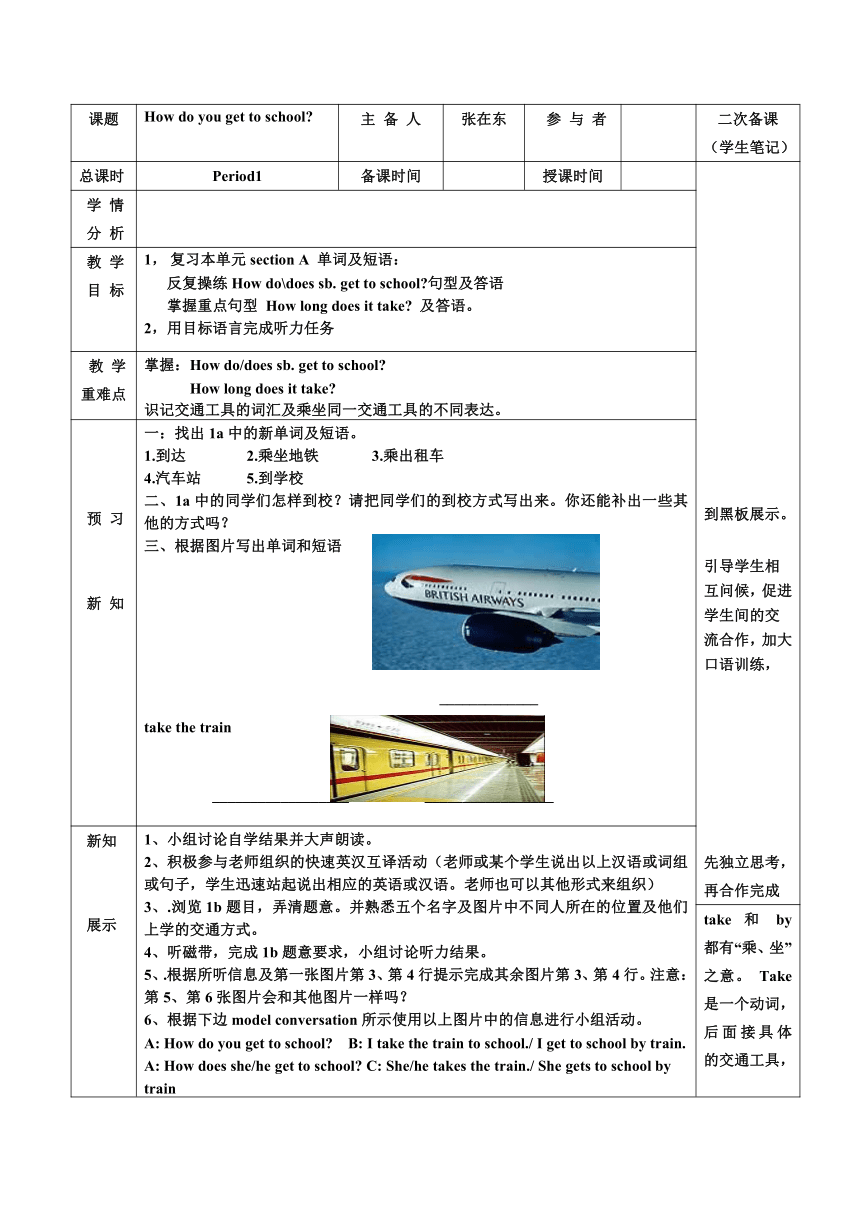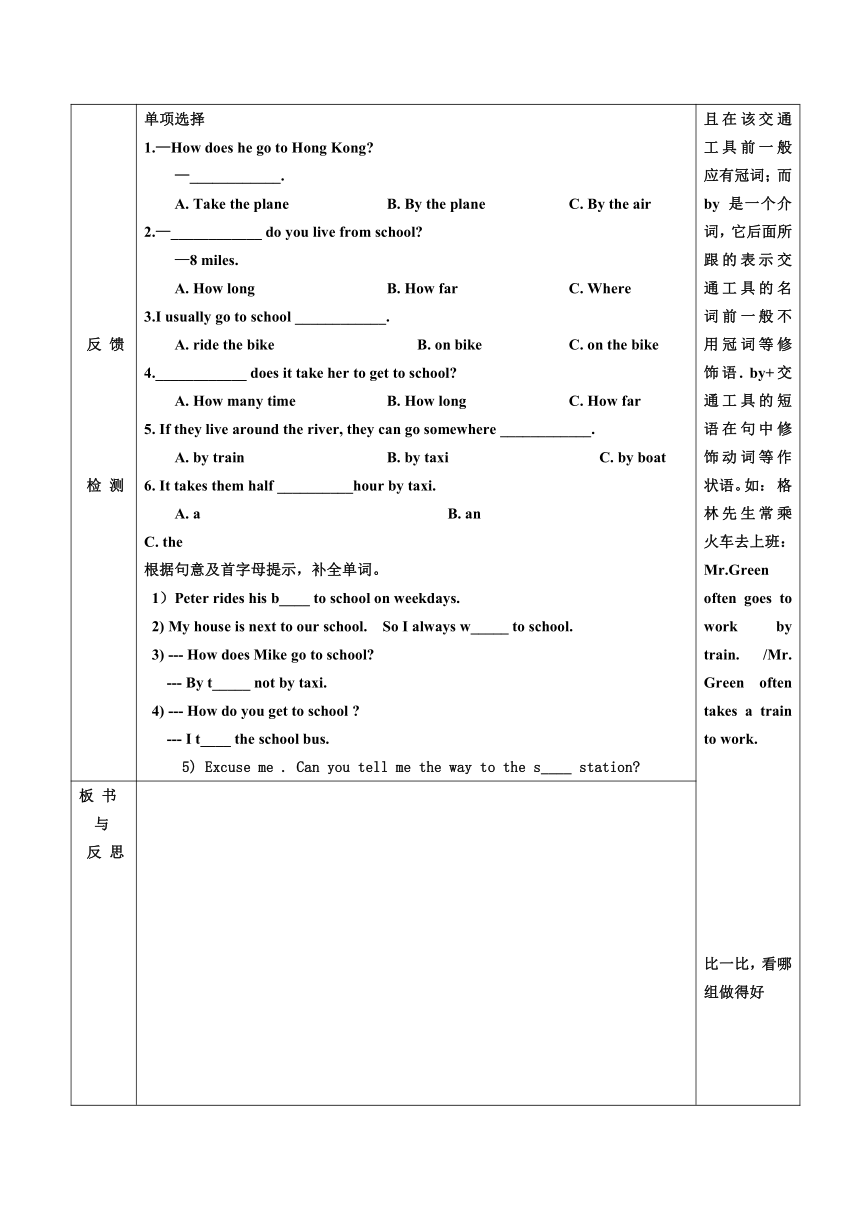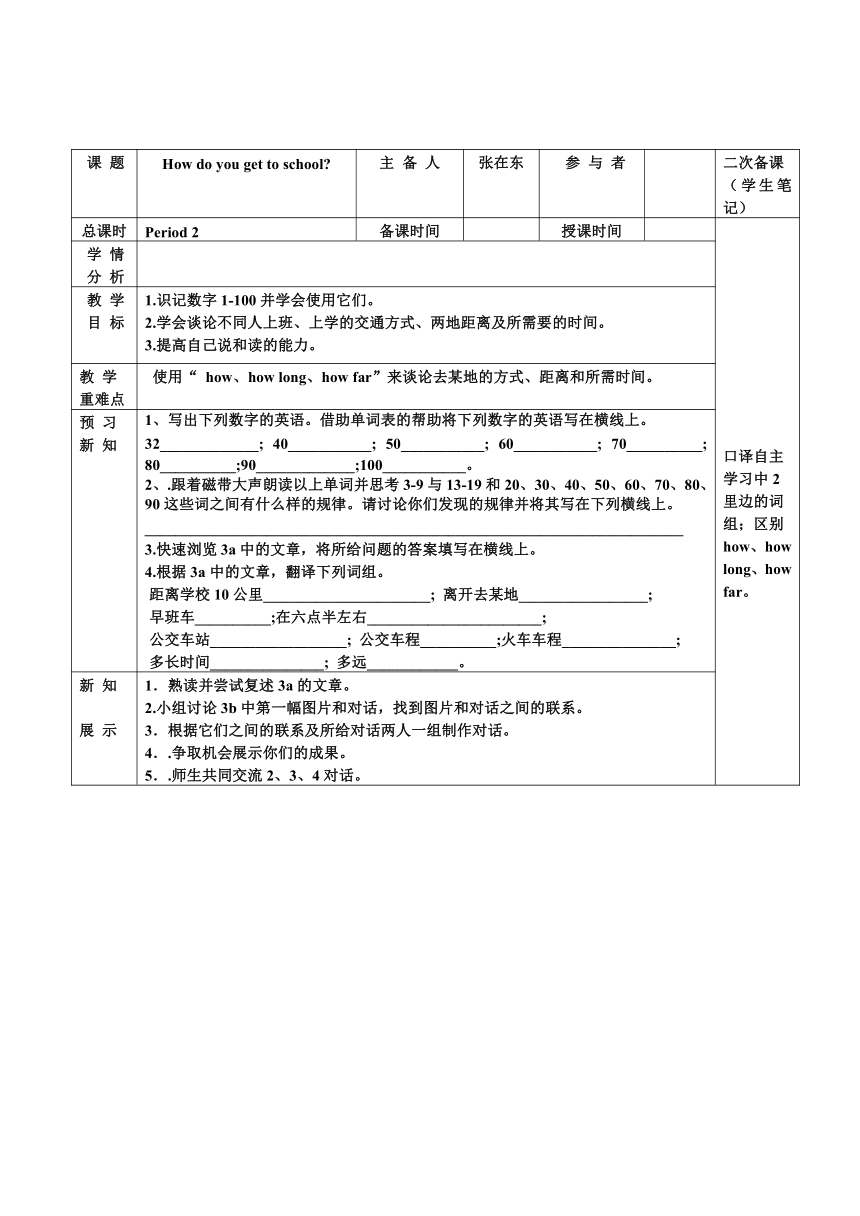Unit 3 How do you get to school?整单元学案
文档属性
| 名称 | Unit 3 How do you get to school?整单元学案 |  | |
| 格式 | zip | ||
| 文件大小 | 42.2KB | ||
| 资源类型 | 教案 | ||
| 版本资源 | 人教新目标(Go for it)版 | ||
| 科目 | 英语 | ||
| 更新时间 | 2016-05-26 19:34:57 | ||
图片预览



文档简介
课题 How do you get to school 主 备 人 张在东 参 与 者 二次备课(学生笔记)
总课时 Period1 备课时间 授课时间 到黑板展示。引导学生相互问候,促进学生间的交流合作,加大口语训练,先独立思考,再合作完成
学 情分 析
教 学目 标 复习本单元section A 单词及短语: 反复操练How do\does sb. get to school 句型及答语掌握重点句型 How long does it take 及答语。2,用目标语言完成听力任务
教 学重难点 掌握:How do/does sb. get to school How long does it take 识记交通工具的词汇及乘坐同一交通工具的不同表达。
预 习新 知 一:找出1a中的新单词及短语。1.到达 2.乘坐地铁 3.乘出租车4.汽车站 5.到学校 二、1a中的同学们怎样到校?请把同学们的到校方式写出来。你还能补出一些其他的方式吗?三、根据图片写出单词和短语 SHAPE \* MERGEFORMAT ( http: / / www.21cnjy.com ) _____________take the train __________________ _________________
新知展示 1、小组讨论自学结果并大声朗读。2、积极 ( http: / / www.21cnjy.com )参与老师组织的快速英汉互译活动( ( http: / / www.21cnjy.com )老师或某个学生说出以上汉语或词组或句子,学生迅速站起说出相应的英语或汉语。老师也可以其他形式来组织)3、.浏览1b题目,弄清题意。并熟悉五个名字及图片中不同人所在的位置及他们上学的交通方式。4、听磁带,完成1b题意要求,小组讨论听力结果。5、.根据所听信息及第一张图片第3、第4行提示完成其余图片第3、第4行。注意:第5、第6张图片会和其他图片一样吗?6、根据下边model conversation所示使用以上图片中的信息进行小组活动。A: How do you get to ( http: / / www.21cnjy.com )school B: I take the train to school./ I get to school by train.A: How does she/he get to school C: She/he takes the train./ She gets to school by train
take 和 by 都有“ ( http: / / www.21cnjy.com )乘、坐”之意。 Take 是一个动词,后面接具体的交通工具,且在该交通工具前一般应有冠词;而 by 是一个介词,它后面所跟的表示交通工具的名词前一般不用冠词等修饰语. by+交通工具的短语在句中修饰动词等作状语。如: 格林先生常乘火车去上班:Mr.Green often goes to work by train. /Mr. Green often takes a train to work. 比一比,看哪组做得好
反 馈检 测 单项选择1.—How does he go to Hong Kong —____________.A. Take the plane B. By the plane C. By the air2.—____________ do you live from school —8 miles.A. How long B. How far C. Where3.I usually go to school ____________.A. ride the bike B. on bike C. on the bike4.____________ does it take her to get to school A. How many time B. How long C. How far5. If they live around the river, they can go somewhere ____________.A. by train B. by taxi C. by boat6. It takes them half __________hour by taxi.A. a B. anC. the 根据句意及首字母提示,补全单词。 1)Peter rides his b____ to school on weekdays. 2) My house is next to our school. So I always w_____ to school. 3) --- How does Mike go to school --- By t_____ not by taxi. 4) --- How do you get to school --- I t____ the school bus. 5) Excuse me . Can you tell me the way to the s____ station
板 书与反 思
课 题 How do you get to school 主 备 人 张在东 参 与 者 二次备课(学生笔记)
总课时 Period 2 备课时间 授课时间 口译自主学习中2里边的词组;区别how、how long、how far。
学 情分 析
教 学目 标 1.识记数字1-100并学会使用它们。2.学会谈论不同人上班、上学的交通方式、两地距离及所需要的时间。3.提高自己说和读的能力。
教 学重难点 使用“ how、how long、how far”来谈论去某地的方式、距离和所需时间。
预 习新 知 1、写出下列数字的英语。借助单词表的帮助将下列数字的英语写在横线上。32_____________; 40___________; 50___________; 60___________; 70__________; 80__________;90_____________;100___________。2、.跟着磁带大声朗读以上单词并思 ( http: / / www.21cnjy.com )考3-9与13-19和20、30、40、50、60、70、80、90这些词之间有什么样的规律。请讨论你们发现的规律并将其写在下列横线上。_______________________________________________________________________3.快速浏览3a中的文章,将所给问题的答案填写在横线上。 4.根据3a中的文章,翻译下列词组。距离学校10公里______________________; 离开去某地_________________; 早班车__________;在六点半左右_______________________; 公交车站__________________; 公交车程__________;火车车程_______________; 多长时间_______________; 多远____________。
新 知 展 示 1.熟读并尝试复述3a的文章。2.小组讨论3b中第一幅图片和对话,找到图片和对话之间的联系。3.根据它们之间的联系及所给对话两人一组制作对话。4..争取机会展示你们的成果。5..师生共同交流2、3、4对话。
反 馈检 测 选择1.I think it may _______ them about two hours to do the work. A. start B. pay C. make D. take 2.Class was over. All the students stopped ______ and left.A. write B. to write C. writing D. wrote 3.--_________ do you u ( http: / / www.21cnjy.com )sually come to school in the morning --By bike. A. What B. Where C. When D. How 4. ________ too much is bad for your health. A. Watching T ( http: / / www.21cnjy.com )V B. Watch TV C. Taking a walk after supper D. Take a walk after supper 5.The old man goes to the park _________ every morning. A. by foot B. by feet C. on foot D. on feet 6.--_______ does it take --It takes about half an hour. A. What time B. When C. How D. How long
板 书与反 思
课 题 Unit 6 How do you get to school 主 备 人 张在东 参 与 者 二次备课
总课时 Period3 备课时间 授课时间 回顾宾语从句的相关知识。
学 情分 析
教 学目 标 1.识记并运用bus stop, bus station, train station, subway station这几个词。2.提高自己的听力技巧。3.能识别出宾语从句及其引导词。4.能区别特殊疑问句的语序和宾语从句的语序。
教 学重难点 在英语语速很快的情况下记录下重要的信息;宾语从句的要领。
预 习新 知 温故知新:1.请回忆昨天所学内容并完成下列词组翻译。距离学校10公里____ ( http: / / www.21cnjy.com )_________________; 离开去某地_________________; 早班车____________;在六点半左右_______________________; 公交车站__________________; 公交车程__________;火车车程_______________; 多长时间_______________; 多远____________。2.说出how long、how fa ( http: / / www.21cnjy.com )r、how many、how much、how often、how soon、how old、how 这些特殊疑问词的相同点和不同点。3、bus stop与bus station有什么区别?
新 知 展 示 1.Complete 1a wit ( http: / / www.21cnjy.com )h the help of the four pictures and tell the differences between “stop”and “station”(参照图片完成1a并辨析 “stop”和“station”两个词)。 2.Check the answer o ( http: / / www.21cnjy.com )f 1a and practice reading these words in it(核对1a答案并朗读里边的单词)。3.Pairwork to prac ( http: / / www.21cnjy.com )tice making conversations imitating the model conversation from 1b and try to take the chance to show your conversation.(两人一组模仿1b中的对话按要求制作自己的对话并争取机会展示你们的对话)4.Look through the ( http: / / www.21cnjy.com )five sentences in 2a and group work to discuss what kind of sentences they are with the help of Language Link(知识链接) as well as the meaning。。(浏览2a中的5个句子并在知识链接的帮助下讨论它们属于什么类型的句子及其意思) 5.Try to descri ( http: / / www.21cnjy.com )be the pictures in 2b in groups and make sure that each group member understands the requirement of 2a and 2b.(小组试着描述2b中的图片并确保每一位小组成员弄清楚2a、2b的题目要求)6.Listen to the tap ( http: / / www.21cnjy.com )e and complete 2a and 2b. Then check the answer(听磁带,完成2a、2b的要求;然后核对答案)7.Group work to descr ( http: / / www.21cnjy.com )ibe the checked pictures. You can look through the listening material of 2a and 2b if necessary before you describe it.(小组描述被勾到的图片。如果有必要,你可以在描述之前浏览它们的听力材料。)8.Take the chance to show yourselves.
反 馈检 测 1. I don’t know ___________________.A. what does h ( http: / / www.21cnjy.com )e like best B. what he like best C. what he does like best D. what he likes best 2. Can you tell me ______________________ A. where she lives ( http: / / www.21cnjy.com ) B. where does she live C. she lives where D. where she live3. He asked me _______________________________.A. what time is it ( http: / / www.21cnjy.com ) B. what time it is C. what time was it D. what time it was4. Do you know _______________________ A. how much did it cost B. how much it did cost C. how much it cost D. how much does it cost
板 书与反 思
课题 How do you get to school 主 备 人 张在东 参 与 者 二次备课(学生笔记)
总课时 Period 4 备课时间 授课时间 到黑板展示。先独立思考,再合作完成
学 情分 析
教 学目 标 1.识记并运用3a、3b中出现的重要单词和词组。2.提高自己的阅读能力。3.提高自己的写作技巧和能力。
教 学重难点 相同交通方式的不同表达;写作技巧的把握和写作能力的提升。
预 习新 知 一、在3a中,有三种表达交通方式的方 ( http: / / www.21cnjy.com )法,你能总结一下吗?1、other是 ____词,意为______.修饰名词作定语;others是 _______ 词,意为_______ 。2、That must be a lot more fun than taking a bus.①句中的that指代的是 _________。②句中的must表________,意为___________ 。二、仔细观察3b中的图表和文章,完成下列要求:1.写出下列数字相对应的单词。40__________; 100__________; 175__________; 30__________; 50____________。2.思考文章中第一个横线上为什么要填写“ ride their bikes”而不是“Bike”?可否在横线上填写by bike 呢?3.请问:“ most students ride their bikes to school=_____________________________
新知展示 一、浏览3a的文章,试一试,看看你能否快速、准确的完成下列短语的翻译。1. 在北美____________; 2. 在南美____________; 3. 在世界的其他地方 ___________________;4. 视……而定___________; 5. 乘船去上学________________; 6 更有趣的多_____________________;7.与… …不一样_____________; 8. 三种最受欢迎的到校方式____________________________; 9. 最受欢迎的交通方式____________________________________。二、同老师核对答案,后大声朗读并识记它们。三、用心阅读3a中的5个句子,弄清它们的意思,并对照文章判断正误。四、小组核对答案并讨论自己做出选择的原因。五、根据图表完成3b。六、 核对答案。
口译所学重要词组;3a这篇文章中使用的写作技巧。比一比,看哪组做得好。学生整理本节课的知识点。。
反 馈检 测 .用所给词的适当形式填空。1 It usually takes ( http: / / www.21cnjy.com )10 minutes _______(walk) from the classroom to the library 2.How long ____ it_____ (take) you to school on weekdays 3.Shanghai is one of the biggest ______ (city) the world.4.________(take) a b ( http: / / www.21cnjy.com )oat to school must _____(be) a lot more fun than taking a bus.5.A small number ( http: / / www.21cnjy.com )of ________ (child) like to eat porridge in the morning.6.The three of the ( http: / / www.21cnjy.com ) most popular ways of _______(get) there are bus, train and bike.7.When it _____ (rain), I often take a taxi to school.8.I’m so tired, I need ______ (have) a good rest.9.Let me _______(help) you _____ (clean) the room.
板 书与反 思
总课时 Period1 备课时间 授课时间 到黑板展示。引导学生相互问候,促进学生间的交流合作,加大口语训练,先独立思考,再合作完成
学 情分 析
教 学目 标 复习本单元section A 单词及短语: 反复操练How do\does sb. get to school 句型及答语掌握重点句型 How long does it take 及答语。2,用目标语言完成听力任务
教 学重难点 掌握:How do/does sb. get to school How long does it take 识记交通工具的词汇及乘坐同一交通工具的不同表达。
预 习新 知 一:找出1a中的新单词及短语。1.到达 2.乘坐地铁 3.乘出租车4.汽车站 5.到学校 二、1a中的同学们怎样到校?请把同学们的到校方式写出来。你还能补出一些其他的方式吗?三、根据图片写出单词和短语 SHAPE \* MERGEFORMAT ( http: / / www.21cnjy.com ) _____________take the train __________________ _________________
新知展示 1、小组讨论自学结果并大声朗读。2、积极 ( http: / / www.21cnjy.com )参与老师组织的快速英汉互译活动( ( http: / / www.21cnjy.com )老师或某个学生说出以上汉语或词组或句子,学生迅速站起说出相应的英语或汉语。老师也可以其他形式来组织)3、.浏览1b题目,弄清题意。并熟悉五个名字及图片中不同人所在的位置及他们上学的交通方式。4、听磁带,完成1b题意要求,小组讨论听力结果。5、.根据所听信息及第一张图片第3、第4行提示完成其余图片第3、第4行。注意:第5、第6张图片会和其他图片一样吗?6、根据下边model conversation所示使用以上图片中的信息进行小组活动。A: How do you get to ( http: / / www.21cnjy.com )school B: I take the train to school./ I get to school by train.A: How does she/he get to school C: She/he takes the train./ She gets to school by train
take 和 by 都有“ ( http: / / www.21cnjy.com )乘、坐”之意。 Take 是一个动词,后面接具体的交通工具,且在该交通工具前一般应有冠词;而 by 是一个介词,它后面所跟的表示交通工具的名词前一般不用冠词等修饰语. by+交通工具的短语在句中修饰动词等作状语。如: 格林先生常乘火车去上班:Mr.Green often goes to work by train. /Mr. Green often takes a train to work. 比一比,看哪组做得好
反 馈检 测 单项选择1.—How does he go to Hong Kong —____________.A. Take the plane B. By the plane C. By the air2.—____________ do you live from school —8 miles.A. How long B. How far C. Where3.I usually go to school ____________.A. ride the bike B. on bike C. on the bike4.____________ does it take her to get to school A. How many time B. How long C. How far5. If they live around the river, they can go somewhere ____________.A. by train B. by taxi C. by boat6. It takes them half __________hour by taxi.A. a B. anC. the 根据句意及首字母提示,补全单词。 1)Peter rides his b____ to school on weekdays. 2) My house is next to our school. So I always w_____ to school. 3) --- How does Mike go to school --- By t_____ not by taxi. 4) --- How do you get to school --- I t____ the school bus. 5) Excuse me . Can you tell me the way to the s____ station
板 书与反 思
课 题 How do you get to school 主 备 人 张在东 参 与 者 二次备课(学生笔记)
总课时 Period 2 备课时间 授课时间 口译自主学习中2里边的词组;区别how、how long、how far。
学 情分 析
教 学目 标 1.识记数字1-100并学会使用它们。2.学会谈论不同人上班、上学的交通方式、两地距离及所需要的时间。3.提高自己说和读的能力。
教 学重难点 使用“ how、how long、how far”来谈论去某地的方式、距离和所需时间。
预 习新 知 1、写出下列数字的英语。借助单词表的帮助将下列数字的英语写在横线上。32_____________; 40___________; 50___________; 60___________; 70__________; 80__________;90_____________;100___________。2、.跟着磁带大声朗读以上单词并思 ( http: / / www.21cnjy.com )考3-9与13-19和20、30、40、50、60、70、80、90这些词之间有什么样的规律。请讨论你们发现的规律并将其写在下列横线上。_______________________________________________________________________3.快速浏览3a中的文章,将所给问题的答案填写在横线上。 4.根据3a中的文章,翻译下列词组。距离学校10公里______________________; 离开去某地_________________; 早班车__________;在六点半左右_______________________; 公交车站__________________; 公交车程__________;火车车程_______________; 多长时间_______________; 多远____________。
新 知 展 示 1.熟读并尝试复述3a的文章。2.小组讨论3b中第一幅图片和对话,找到图片和对话之间的联系。3.根据它们之间的联系及所给对话两人一组制作对话。4..争取机会展示你们的成果。5..师生共同交流2、3、4对话。
反 馈检 测 选择1.I think it may _______ them about two hours to do the work. A. start B. pay C. make D. take 2.Class was over. All the students stopped ______ and left.A. write B. to write C. writing D. wrote 3.--_________ do you u ( http: / / www.21cnjy.com )sually come to school in the morning --By bike. A. What B. Where C. When D. How 4. ________ too much is bad for your health. A. Watching T ( http: / / www.21cnjy.com )V B. Watch TV C. Taking a walk after supper D. Take a walk after supper 5.The old man goes to the park _________ every morning. A. by foot B. by feet C. on foot D. on feet 6.--_______ does it take --It takes about half an hour. A. What time B. When C. How D. How long
板 书与反 思
课 题 Unit 6 How do you get to school 主 备 人 张在东 参 与 者 二次备课
总课时 Period3 备课时间 授课时间 回顾宾语从句的相关知识。
学 情分 析
教 学目 标 1.识记并运用bus stop, bus station, train station, subway station这几个词。2.提高自己的听力技巧。3.能识别出宾语从句及其引导词。4.能区别特殊疑问句的语序和宾语从句的语序。
教 学重难点 在英语语速很快的情况下记录下重要的信息;宾语从句的要领。
预 习新 知 温故知新:1.请回忆昨天所学内容并完成下列词组翻译。距离学校10公里____ ( http: / / www.21cnjy.com )_________________; 离开去某地_________________; 早班车____________;在六点半左右_______________________; 公交车站__________________; 公交车程__________;火车车程_______________; 多长时间_______________; 多远____________。2.说出how long、how fa ( http: / / www.21cnjy.com )r、how many、how much、how often、how soon、how old、how 这些特殊疑问词的相同点和不同点。3、bus stop与bus station有什么区别?
新 知 展 示 1.Complete 1a wit ( http: / / www.21cnjy.com )h the help of the four pictures and tell the differences between “stop”and “station”(参照图片完成1a并辨析 “stop”和“station”两个词)。 2.Check the answer o ( http: / / www.21cnjy.com )f 1a and practice reading these words in it(核对1a答案并朗读里边的单词)。3.Pairwork to prac ( http: / / www.21cnjy.com )tice making conversations imitating the model conversation from 1b and try to take the chance to show your conversation.(两人一组模仿1b中的对话按要求制作自己的对话并争取机会展示你们的对话)4.Look through the ( http: / / www.21cnjy.com )five sentences in 2a and group work to discuss what kind of sentences they are with the help of Language Link(知识链接) as well as the meaning。。(浏览2a中的5个句子并在知识链接的帮助下讨论它们属于什么类型的句子及其意思) 5.Try to descri ( http: / / www.21cnjy.com )be the pictures in 2b in groups and make sure that each group member understands the requirement of 2a and 2b.(小组试着描述2b中的图片并确保每一位小组成员弄清楚2a、2b的题目要求)6.Listen to the tap ( http: / / www.21cnjy.com )e and complete 2a and 2b. Then check the answer(听磁带,完成2a、2b的要求;然后核对答案)7.Group work to descr ( http: / / www.21cnjy.com )ibe the checked pictures. You can look through the listening material of 2a and 2b if necessary before you describe it.(小组描述被勾到的图片。如果有必要,你可以在描述之前浏览它们的听力材料。)8.Take the chance to show yourselves.
反 馈检 测 1. I don’t know ___________________.A. what does h ( http: / / www.21cnjy.com )e like best B. what he like best C. what he does like best D. what he likes best 2. Can you tell me ______________________ A. where she lives ( http: / / www.21cnjy.com ) B. where does she live C. she lives where D. where she live3. He asked me _______________________________.A. what time is it ( http: / / www.21cnjy.com ) B. what time it is C. what time was it D. what time it was4. Do you know _______________________ A. how much did it cost B. how much it did cost C. how much it cost D. how much does it cost
板 书与反 思
课题 How do you get to school 主 备 人 张在东 参 与 者 二次备课(学生笔记)
总课时 Period 4 备课时间 授课时间 到黑板展示。先独立思考,再合作完成
学 情分 析
教 学目 标 1.识记并运用3a、3b中出现的重要单词和词组。2.提高自己的阅读能力。3.提高自己的写作技巧和能力。
教 学重难点 相同交通方式的不同表达;写作技巧的把握和写作能力的提升。
预 习新 知 一、在3a中,有三种表达交通方式的方 ( http: / / www.21cnjy.com )法,你能总结一下吗?1、other是 ____词,意为______.修饰名词作定语;others是 _______ 词,意为_______ 。2、That must be a lot more fun than taking a bus.①句中的that指代的是 _________。②句中的must表________,意为___________ 。二、仔细观察3b中的图表和文章,完成下列要求:1.写出下列数字相对应的单词。40__________; 100__________; 175__________; 30__________; 50____________。2.思考文章中第一个横线上为什么要填写“ ride their bikes”而不是“Bike”?可否在横线上填写by bike 呢?3.请问:“ most students ride their bikes to school=_____________________________
新知展示 一、浏览3a的文章,试一试,看看你能否快速、准确的完成下列短语的翻译。1. 在北美____________; 2. 在南美____________; 3. 在世界的其他地方 ___________________;4. 视……而定___________; 5. 乘船去上学________________; 6 更有趣的多_____________________;7.与… …不一样_____________; 8. 三种最受欢迎的到校方式____________________________; 9. 最受欢迎的交通方式____________________________________。二、同老师核对答案,后大声朗读并识记它们。三、用心阅读3a中的5个句子,弄清它们的意思,并对照文章判断正误。四、小组核对答案并讨论自己做出选择的原因。五、根据图表完成3b。六、 核对答案。
口译所学重要词组;3a这篇文章中使用的写作技巧。比一比,看哪组做得好。学生整理本节课的知识点。。
反 馈检 测 .用所给词的适当形式填空。1 It usually takes ( http: / / www.21cnjy.com )10 minutes _______(walk) from the classroom to the library 2.How long ____ it_____ (take) you to school on weekdays 3.Shanghai is one of the biggest ______ (city) the world.4.________(take) a b ( http: / / www.21cnjy.com )oat to school must _____(be) a lot more fun than taking a bus.5.A small number ( http: / / www.21cnjy.com )of ________ (child) like to eat porridge in the morning.6.The three of the ( http: / / www.21cnjy.com ) most popular ways of _______(get) there are bus, train and bike.7.When it _____ (rain), I often take a taxi to school.8.I’m so tired, I need ______ (have) a good rest.9.Let me _______(help) you _____ (clean) the room.
板 书与反 思
同课章节目录
- Unit 1 Can you play the guitar?
- Section A
- Section B
- Unit 2 What time do you go to school?
- Section A
- Section B
- Unit 3 How do you get to school?
- Section A
- Section B
- Unit 4 Don't eat in class.
- Section A
- Section B
- Unit 5 Why do you like pandas?
- Section A
- Section B
- Unit 6 I'm watching TV.
- Section A
- Section B
- Review of Units 1-6
- Unit 7 It's raining!
- Section A
- Section B
- Unit 8 Is there a post office near here?
- Section A
- Section B
- Unit 9 What does he look like?
- Section A
- Section B
- Unit 10 I'd like some noodles.
- Section A
- Section B
- Unit 11 How was your school trip?
- Section A
- Section B
- Unit 12 What did you do last weekend?
- Section A
- Section B
